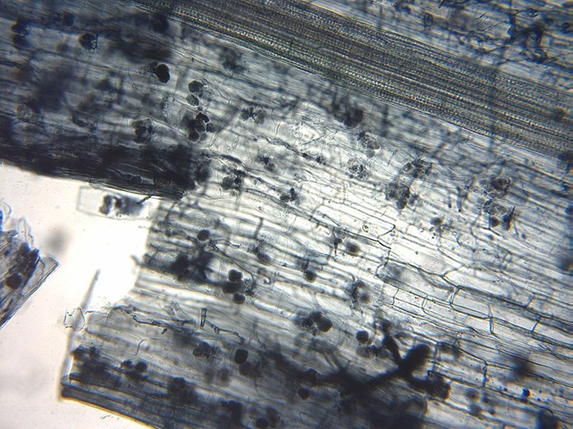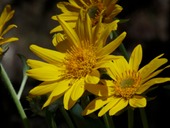A mycorrhiza is a symbiotic association between a fungus and the roots of a vascular plant
Glomus intraradices is an arbuscular mycorrhizal fungus used as a soil inoculant in agriculture and horticulture.
An arbuscular mycorrhiza (plural mycorrhizae or mycorrhizas, aka AM Fungi) is a type of mycorrhiza in which the fungus penetrates the cortical cells of the roots of a vascular plant.
Arbuscular mycorrhizae (AMs) are characterized by the formation of unique structures such as arbuscules and vesicles by fungi of the phylum Glomeromycota (AM fungi). AM fungi (AMF) help plants to capture nutrients such as phosphorus, sulfur, nitrogen and micronutrients from the soil. It is believed that the development of the arbuscular mycorrhizal symbiosis played a crucial role in the initial colonisation of land by plants and in the evolution of the vascular plants.[1]
It has been said that it is quicker to list the plants that do not form mycorrhizae than those that do.[2] This symbiosis is a highly evolved mutualistic relationship found between fungi and plants, the most prevalent plant symbiosis known,[3] and AM is found in 80% of vascular plant families in existence today.[4]

The tremendous advances in research on mycorrhizal physiology and ecology over the past 40 years have led to a greater understanding of the multiple roles of AMF in the ecosystem. This knowledge is applicable to human endeavors of ecosystem management, ecosystem restoration, and agriculture.
.The rhizosphere is the narrow region of soil that is directly influenced by root secretions and associated soil microorganisms. Soil which is not part of the rhizosphere is known as bulk soil. The rhizosphere contains many bacteria that feed on sloughed-off plant cells, termed rhizodeposition, and the proteins and sugars released by roots. Protozoa and nematodes that graze on bacteria are also more abundant in the rhizosphere. Thus, much of the nutrient cycling and disease suppression needed by plants occurs immediately adjacent to roots.
A biofertilizer (also bio-fertilizer) is a substance which contains living microorganisms which, when applied to seed, plant surfaces, or soil, colonizes the rhizosphere or the interior of the plant and promotes growth by increasing the supply or availability of primary nutrients to the host plant. Bio-fertilizers add nutrients through the natural processes of nitrogen fixation, solubilizing phosphorus, and stimulating plant growth through the synthesis of growth-promoting substances. Bio-fertilizers can be expected to reduce the use of chemical fertilizers and pesticides. The microorganisms in bio-fertilizers restore the soil's natural nutrient cycle and build soil organic matter. Through the use of bio-fertilizers, healthy plants can be grown, while enhancing the sustainability and the health of the soil. Since they play several roles, a preferred scientific term for such beneficial bacteria is "plant-growth promoting rhizobacteria" (PGPR). Therefore, they are extremely advantageous in enriching soil fertility and fulfilling plant nutrient requirements by supplying the organic nutrients through microorganism and their byproducts. Hence, bio-fertilizers do not contain any chemicals which are harmful to the living soil.
Bio-fertilizers eco friendly organic agro-input and more cost-effective than chemical fertilizers. Bio-fertilizers such as Rhizobium,Azotobacter, Azospirillum and blue green algae (BGA) have been in use a long time. Rhizobiuminoculant is used for leguminous crops.Azotobacter can be used with crops like wheat, maize, mustard, cotton, potato and other vegetable crops. Azospirillum inoculations are recommended mainly for sorghum, millets, maize, sugarcane and wheat. Blue green algae belonging to a general cyanobacteria genus,Nostoc or Anabaena or Tolypothrix or Aulosira, fix atmospheric nitrogen and are used as inoculations for paddy crop grown both under upland and low-land conditions. Anabaena in association with water fern Azolla contributes nitrogen up to 60 kg/ha/season and also enriches soils with organic matter.
Other types of bacteria, so-called phosphate-solubilizing bacteria, such as Pantoea agglomerans strain P5 or Pseudomonas putida strain P13,are able to solubilize the insoluble phosphate from organic and inorganic phosphate sources. In fact, due to immobilization of phosphate by mineral ions such as Fe, Al and Ca or organic acids, the rate of available phosphate (Pi) in soil is well below plant needs. In addition, chemical Pi fertilizers are also immobilized in the soil, immediately, so that less than 20 percent of added fertilizer is absorbed by plants. Therefore, reduction in Pi resources, on one hand, and environmental pollutions resulting from both production and applications of chemical Pi fertilizer, on the other hand, have already demanded the use of new generation of phosphate fertilizers globally known as phosphate-solubilizing bacteria or phosphate bio-fertilizers.
